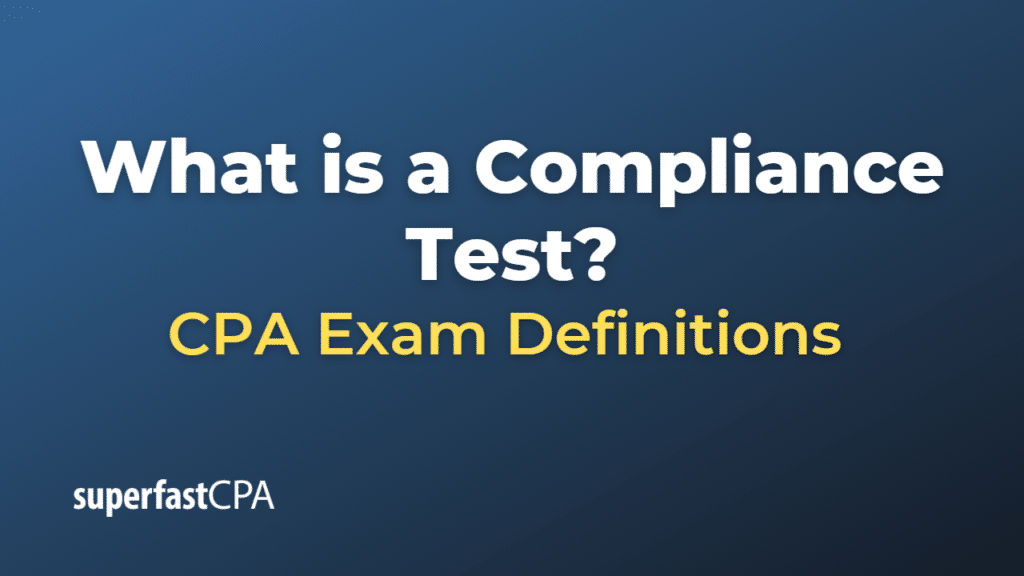Compliance Test
A compliance test, also known as a compliance testing or substantive testing, is a type of audit procedure used by auditors to evaluate whether an organization’s transactions, processes, or controls are in accordance with the relevant laws, regulations, industry standards, or internal policies that apply to its operations. Compliance tests help auditors assess an organization’s adherence to the applicable rules and guidelines and identify any areas of non-compliance that may require corrective action.
Compliance tests can be performed on various aspects of an organization’s operations, such as financial reporting, tax compliance, environmental regulations, health and safety, information security, or human resources. The specific tests and procedures used in a compliance test will depend on the nature of the organization and the particular rules or guidelines that apply to its operations.
Examples of compliance tests include:
- Reviewing financial transactions and supporting documentation to ensure that they are accurately recorded and comply with the relevant accounting standards, such as the Generally Accepted Accounting Principles (GAAP) or International Financial Reporting Standards (IFRS).
- Examining payroll records and employee files to verify that the organization is in compliance with labor laws and regulations, such as minimum wage requirements, overtime rules, or employee benefits.
- Inspecting facilities and equipment to assess compliance with environmental, health, and safety regulations, such as proper storage and disposal of hazardous materials or adherence to workplace safety standards.
- Testing IT systems and data security measures to ensure compliance with data protection and privacy regulations, such as the General Data Protection Regulation (GDPR) in the European Union or the Health Insurance Portability and Accountability Act (HIPAA) for healthcare organizations in the United States.
- Evaluating internal controls and risk management processes to ensure they are effective in preventing, detecting, and correcting instances of non-compliance.
The results of compliance tests are typically included in an audit report, which outlines the auditor’s findings, identifies any areas of non-compliance, and provides recommendations for corrective actions that the organization should take to address these issues. Compliance tests are crucial for organizations to maintain their reputation, avoid potential fines and penalties associated with regulatory violations, and ensure that they operate ethically and responsibly within their industry.
Example of a Compliance Test
Let’s consider a hypothetical example of a manufacturing company, ManuCo, which undergoes an audit that includes compliance tests to assess its adherence to environmental, health, and safety regulations.
ManuCo operates a production facility where it manufactures various products using hazardous materials and heavy machinery. As a result, the company is subject to various environmental, health, and safety regulations, such as the Clean Air Act, Clean Water Act, and Occupational Safety and Health Act (OSHA).
During the audit, the auditors perform a series of compliance tests to evaluate ManuCo’s compliance with these regulations. Some examples of these tests include:
- Inspecting the production facility to ensure that the company has implemented proper controls to prevent air and water pollution, such as installing emissions control equipment or implementing wastewater treatment processes.
- Reviewing records and permits related to the handling, storage, and disposal of hazardous materials to ensure that ManuCo is in compliance with the applicable regulations.
- Examining safety procedures, training records, and incident reports to verify that ManuCo is taking the necessary steps to protect the health and safety of its employees, such as providing appropriate personal protective equipment and conducting regular safety training sessions.
- Testing the effectiveness of ManuCo’s internal controls and risk management processes related to environmental, health, and safety compliance, such as ensuring that incidents or violations are promptly reported and addressed.
- Interviewing key personnel, such as the environmental compliance manager and the safety officer, to gather additional information and insights regarding the company’s compliance efforts.
Upon completing the compliance tests, the auditors identify a few instances of non-compliance, such as inadequate training for handling hazardous materials and the lack of proper safety signage in certain areas of the production facility. The auditors include these findings in their audit report, along with recommendations for corrective actions that ManuCo should take to address these issues.
By undergoing compliance tests as part of the audit process, ManuCo can identify potential areas of non-compliance, take corrective actions to improve its environmental, health, and safety performance, and demonstrate its commitment to operating ethically and responsibly within its industry.













